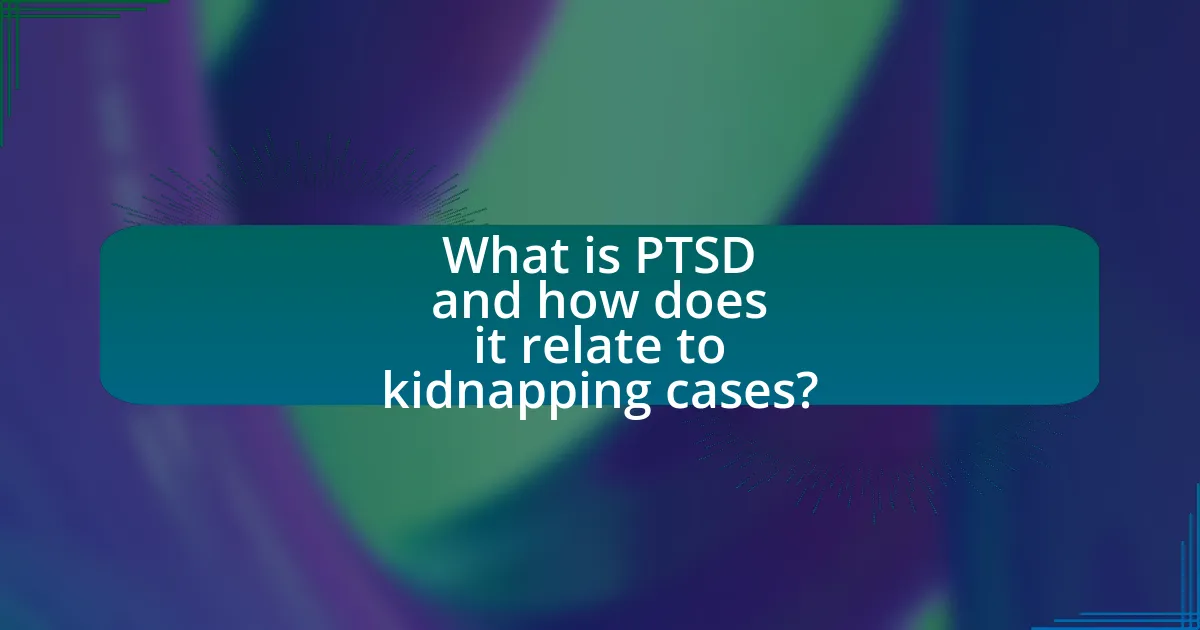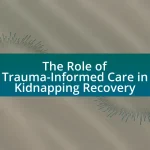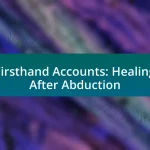Post-Traumatic Stress Disorder (PTSD) is a mental health condition that can develop after experiencing or witnessing traumatic events, such as kidnapping. This article explores the relationship between PTSD and kidnapping, detailing its symptoms, the differences in manifestation between children and adults, and the common causes of PTSD in these scenarios. It highlights the impact of captivity duration and the nature of the kidnapping on PTSD severity, emphasizing the importance of understanding PTSD for effective recovery. Additionally, the article discusses therapeutic approaches, the role of support groups, and practical steps to aid survivors in their healing process.

What is PTSD and how does it relate to kidnapping cases?
Post-Traumatic Stress Disorder (PTSD) is a mental health condition triggered by experiencing or witnessing a traumatic event, characterized by symptoms such as flashbacks, severe anxiety, and uncontrollable thoughts about the event. In kidnapping cases, victims often experience extreme trauma, leading to the development of PTSD as they may relive the event through intrusive memories and nightmares, struggle with emotional numbness, and face heightened arousal symptoms like irritability and hypervigilance. Research indicates that approximately 30% of individuals exposed to traumatic events, such as kidnapping, may develop PTSD, highlighting the significant psychological impact of such experiences.
How is PTSD defined in the context of trauma?
PTSD, or Post-Traumatic Stress Disorder, is defined as a mental health condition that arises after experiencing or witnessing a traumatic event, such as kidnapping. This disorder is characterized by symptoms including intrusive memories, avoidance of reminders of the trauma, negative changes in mood and cognition, and heightened arousal responses. Research indicates that individuals exposed to traumatic events, like kidnapping, are at a significantly increased risk of developing PTSD, with studies showing that approximately 20-30% of kidnapping survivors may experience this condition.
What are the key symptoms of PTSD?
The key symptoms of PTSD include intrusive memories, avoidance behaviors, negative changes in mood and cognition, and heightened arousal. Intrusive memories manifest as flashbacks or distressing thoughts related to the traumatic event. Avoidance behaviors involve steering clear of reminders of the trauma, such as places or people associated with the event. Negative changes in mood and cognition can lead to feelings of hopelessness, emotional numbness, or difficulty in maintaining relationships. Heightened arousal is characterized by symptoms such as irritability, difficulty sleeping, and hypervigilance. These symptoms are recognized in the Diagnostic and Statistical Manual of Mental Disorders (DSM-5), which outlines the criteria for diagnosing PTSD.
How does PTSD manifest differently in children compared to adults?
PTSD manifests differently in children compared to adults primarily through variations in symptoms and coping mechanisms. Children often exhibit more behavioral changes, such as increased aggression, withdrawal, or regressive behaviors, while adults may experience more emotional symptoms like anxiety and depression. Research indicates that children may also have difficulty verbalizing their feelings, leading to somatic complaints, whereas adults typically articulate their distress more clearly. A study published in the Journal of the American Academy of Child & Adolescent Psychiatry found that children exposed to trauma are more likely to display externalizing behaviors, while adults often internalize their trauma, highlighting these distinct manifestations.
What are the common causes of PTSD in kidnapping scenarios?
The common causes of PTSD in kidnapping scenarios include exposure to extreme fear, physical harm, and the violation of personal autonomy. Victims often experience intense psychological distress during the kidnapping, which can lead to lasting trauma. Research indicates that approximately 30% of individuals exposed to traumatic events, such as kidnapping, develop PTSD, highlighting the significant impact of such experiences on mental health. Factors such as the duration of captivity, the nature of the threat, and the victim’s previous trauma history further exacerbate the likelihood of developing PTSD.
How does the duration of captivity influence PTSD development?
The duration of captivity significantly influences the development of PTSD, with longer periods of captivity correlating with increased severity and prevalence of PTSD symptoms. Research indicates that individuals held for extended durations experience more intense trauma exposure, leading to a higher likelihood of developing PTSD. For instance, a study published in the Journal of Traumatic Stress found that hostages held for more than 14 days exhibited PTSD symptoms in 80% of cases, compared to only 30% for those held for shorter periods. This suggests that prolonged exposure to traumatic events during captivity exacerbates psychological distress, ultimately increasing the risk of PTSD.
What role does the nature of the kidnapping play in PTSD severity?
The nature of the kidnapping significantly influences PTSD severity, as factors such as duration, violence, and the relationship to the perpetrator can exacerbate trauma responses. Research indicates that prolonged captivity and exposure to physical harm increase the likelihood of severe PTSD symptoms. For instance, a study published in the Journal of Traumatic Stress found that individuals who experienced violent kidnappings reported higher PTSD severity compared to those who were abducted without violence. Additionally, the emotional connection to the kidnapper, such as familial ties, can complicate the trauma, leading to more intense psychological distress.
Why is understanding PTSD in kidnapping cases crucial for recovery?
Understanding PTSD in kidnapping cases is crucial for recovery because it directly influences the therapeutic approaches and support systems necessary for survivors. PTSD can manifest through symptoms such as flashbacks, severe anxiety, and emotional distress, which can hinder a survivor’s ability to reintegrate into daily life. Research indicates that approximately 30% of individuals exposed to traumatic events, like kidnapping, develop PTSD, highlighting the need for targeted interventions. Effective recovery strategies, including trauma-informed care and cognitive-behavioral therapy, are essential in addressing these symptoms and facilitating healing. Understanding the specific nature of PTSD in this context allows mental health professionals to tailor their treatment plans, ultimately improving the chances of successful recovery for survivors.
How can early intervention impact the recovery process?
Early intervention can significantly enhance the recovery process for individuals experiencing PTSD from kidnapping. By providing timely psychological support and therapeutic interventions, early intervention helps mitigate the severity of symptoms, reduces the duration of distress, and fosters resilience. Research indicates that individuals who receive early treatment are more likely to experience improved outcomes, such as reduced anxiety and depression levels, compared to those who delay seeking help. A study published in the Journal of Traumatic Stress found that early psychological interventions can lead to a 50% reduction in PTSD symptoms within the first month of treatment, demonstrating the critical role of prompt support in recovery.
What are the long-term effects of untreated PTSD in survivors?
Untreated PTSD in survivors can lead to chronic mental health issues, including severe anxiety, depression, and substance abuse. These long-term effects can manifest as persistent emotional distress, difficulty in maintaining relationships, and impaired daily functioning. Research indicates that individuals with untreated PTSD are at a higher risk for developing comorbid conditions such as major depressive disorder and generalized anxiety disorder, which can exacerbate their overall mental health decline. Furthermore, untreated PTSD can result in significant disruptions in occupational and social functioning, leading to decreased quality of life and increased healthcare costs.
How can we identify signs of PTSD in kidnapping survivors?
Signs of PTSD in kidnapping survivors can be identified through symptoms such as intrusive memories, avoidance behaviors, negative changes in mood and cognition, and heightened arousal. Intrusive memories may manifest as flashbacks or distressing thoughts about the kidnapping experience. Survivors often exhibit avoidance behaviors, such as steering clear of reminders of the trauma or feeling emotionally numb. Negative changes in mood can include persistent feelings of fear, guilt, or shame, while heightened arousal may present as irritability, difficulty sleeping, or hypervigilance. Research indicates that approximately 20% to 30% of individuals exposed to traumatic events, including kidnapping, develop PTSD, highlighting the importance of recognizing these signs for timely intervention and support.
What therapeutic approaches are effective for treating PTSD in these cases?
Cognitive Behavioral Therapy (CBT) and Eye Movement Desensitization and Reprocessing (EMDR) are effective therapeutic approaches for treating PTSD in kidnapping cases. CBT helps individuals reframe negative thoughts and develop coping strategies, while EMDR facilitates the processing of traumatic memories through guided eye movements. Research indicates that both therapies significantly reduce PTSD symptoms; for instance, a meta-analysis published in the Journal of Traumatic Stress found that CBT and EMDR are among the most effective treatments for trauma-related disorders, with effect sizes indicating substantial improvements in symptomatology.
How does cognitive-behavioral therapy help in PTSD recovery?
Cognitive-behavioral therapy (CBT) helps in PTSD recovery by addressing negative thought patterns and behaviors associated with trauma. CBT employs techniques such as exposure therapy, which gradually exposes individuals to trauma-related memories in a controlled environment, reducing anxiety and avoidance behaviors. Research indicates that CBT can significantly decrease PTSD symptoms; for instance, a meta-analysis published in the Journal of Traumatic Stress found that CBT is effective in reducing PTSD symptoms in approximately 60-80% of participants. This evidence supports the efficacy of CBT in facilitating recovery from PTSD, particularly in cases related to traumatic events like kidnapping.
What role do support groups play in the healing process?
Support groups play a crucial role in the healing process for individuals experiencing PTSD, particularly in cases of kidnapping. These groups provide a safe environment where survivors can share their experiences, fostering a sense of community and reducing feelings of isolation. Research indicates that participation in support groups can lead to improved emotional well-being, as members often find validation and understanding from others who have faced similar traumas. A study published in the Journal of Traumatic Stress found that individuals who engaged in peer support reported lower levels of PTSD symptoms and greater overall life satisfaction. This evidence underscores the importance of support groups in facilitating recovery and promoting resilience among survivors of traumatic events.
What practical steps can be taken to support a kidnapping survivor with PTSD?
To support a kidnapping survivor with PTSD, provide a safe and stable environment, as safety is crucial for recovery. Establishing a routine can help the survivor regain a sense of normalcy and control. Encourage professional therapy, particularly trauma-focused cognitive behavioral therapy, which has been shown to be effective for PTSD. Additionally, offer emotional support by actively listening and validating their feelings, which can foster trust and healing. Educate yourself about PTSD to better understand their experiences and reactions, enhancing your ability to provide informed support.


